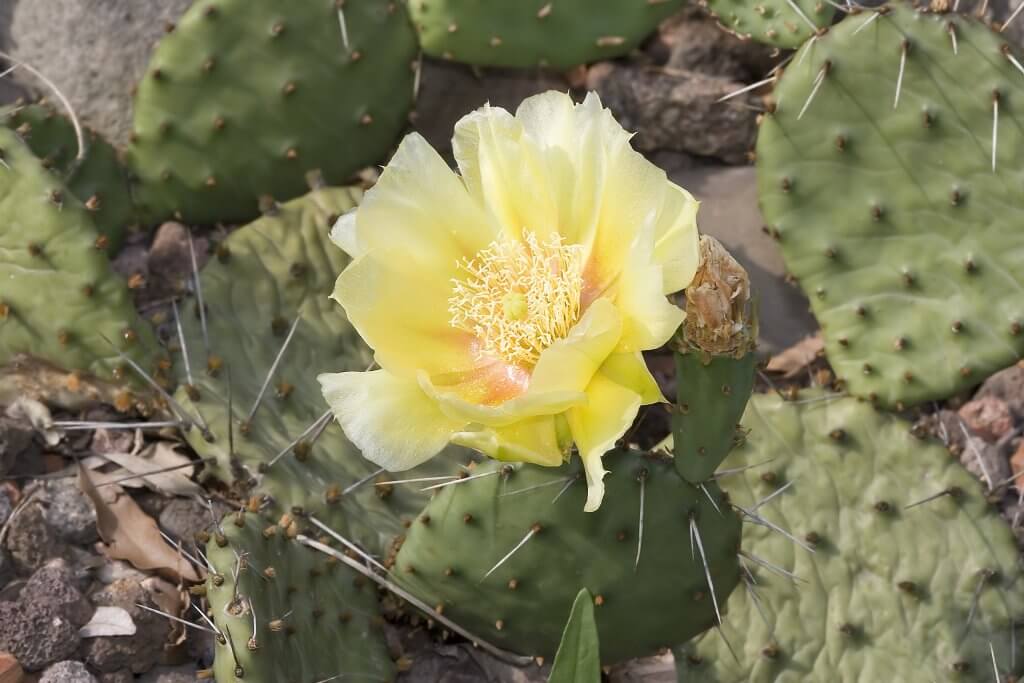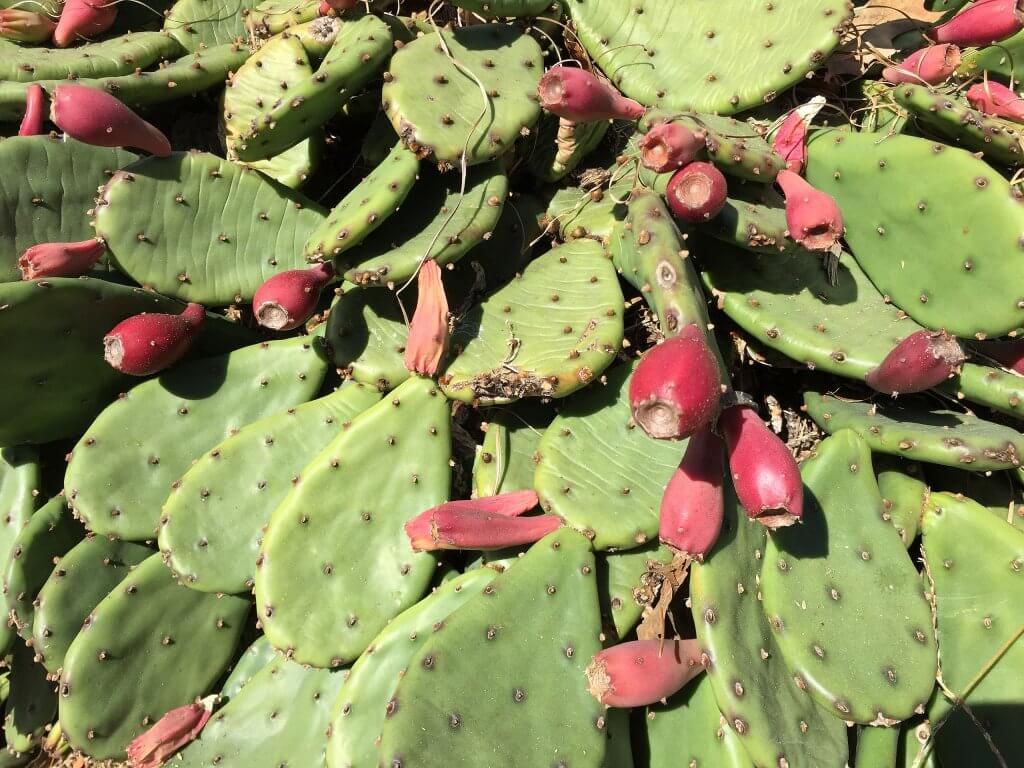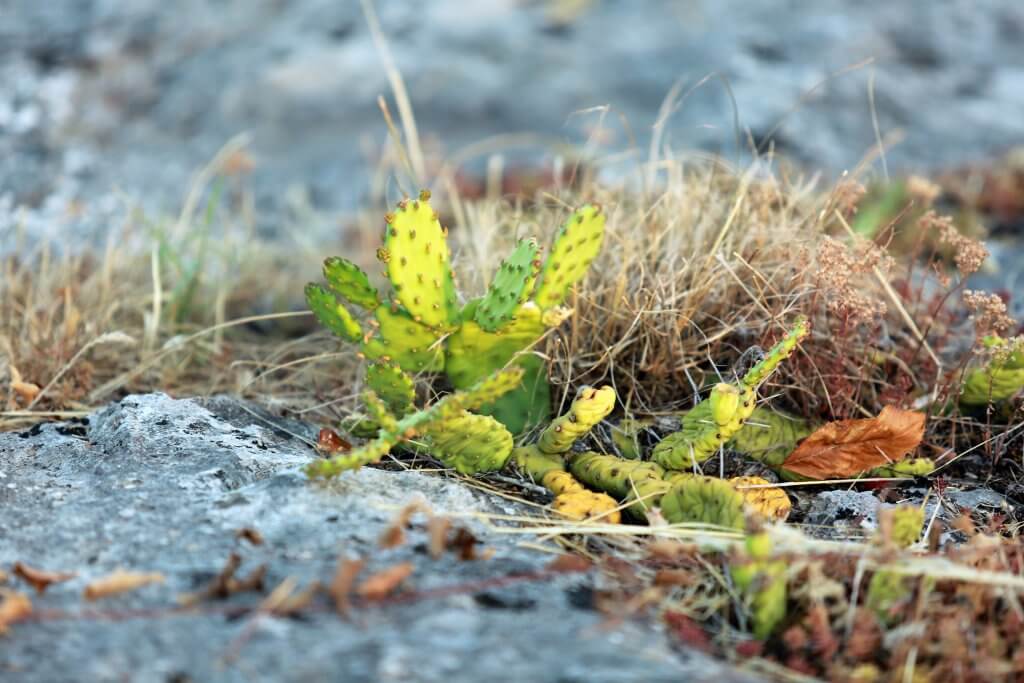Eastern prickly pear (Opuntia humifusa), is a species of cacti that is a common occurrence in sandy and dry soils in the midwest and eastern states. You may also see it being referred to as devil’s-tongue or Indian fig, the latter hinting at its value as a wild edible. As a cactus it can be surprising to come across in the northern states because of the cooler climate. However it is a hardy plant that even makes appearances within Southern Canada, although it is now considered endangered there.

As a member of the Opuntia genus, the eastern prickly pear has the characteristic flattened, succulent leaf pads. They are coated in small clusters of spines, called glochids, that serve as a protection from grazing wildlife. In late spring you’ll be treated to a display of golden hued flowers that emerge along the top edge of the pads. These soon develop into the small juicy fruits, moving from green to ruby red in color.
It is a low growing plant that you’ll typically only find in areas of dry soil. From sand dunes along the coast, to arid, rocky outcrops and even areas of sandy, soiled woodland. Special ‘antifreeze’ compounds enable it to withstand freezing temperatures, as long as the roots remain free of moisture. Although tolerable to the cold, eastern prickly cactus is not shade tolerant. You are unlikely to find it growing within areas of tall or dense vegetation that compete for sunlight.
Edible parts and other uses
Almost all of the above ground parts of the plant, to the surprise of many people, are in fact edible. The young, spineless leaf pads, flowers, fruits and seeds can all be consumed, although a little preparation is usually needed.
The leaf pads must be fully stripped of their outer layer, to remove the possibility of any fine spines still being present. The seeds within the fruit are very solid, so you may choose to remove these. The flowers can be eaten straight from the plant, they have a juicy, mucilage like texture and can be added straight into salads.

The pads have a texture and flavoring similar to okra and milkweed, and can be prepared in much the same way. Fried, roasted or chopped into soups and other hot dishes, they are incredibly versatile. The fruits on the other hand are sweet, and can be eaten raw or made into jams and desserts.
As one of its common names, ‘Indian fig’, suggests, the eastern prickly cactus was considered an important food source for many native Americans. The seeds were frequently ground into an edible flour or paste, and the leaf pads and fruits were eaten in abundance. It was also valued medicinally as well, whether used as a poultice or eaten as a cure for inflammations and respiratory illnesses.
Cautions
As well as the sharp spines, the glochids also sprout very fine hairlike spines which can cause skin irritation for days afterwards. When harvesting young leaves, flowers or fruits, it is often safest to wear a pair of gloves.
No toxic lookalikes exist, so foraging for prickly pear is considered fairly safe for beginners, as long as care is taken with the spines.
Foraging
Look for eastern prickly cacti in dry areas that receive full sunlight throughout the day. Sand dunes and areas of rocky, very well draining soil are the best place to forage.
The pads can be harvested all year round, the flowers in spring and the fruits in late summer. The fruits however, are a favorite for a huge range of wild animals, so you will need to keep a watchful eye as they ripen.

Did you know…
Recent scientific studies show that prickly pear contains compounds that can help to reduce blood sugar levels in diabetic sufferers. Although further study is needed, the results are quite promising.
Conclusion
Full of antioxidants and a good dose of nutrients, the eastern prickly pear is a very worthwhile plant to forage. It is a popular food in Central and Southern America, where prickly pears are commonly found in markets and supermarkets. It would make a great native plant to grow at home in your yard for your own beneficial source of tasty fruits and succulent leaves.
—————Written by Hannah Sweet
Hannah is a freelance writer and graphic designer from the UK. With a penchant for travelling, photography and all things botanical, she enjoys writing about a wealth of topics and issues, from conservation and slow living, to design and travel. Learn more about her writing and design services at www.sweetmeanders.co
Many of our readers find that subscribing to Eat The Planet is the best way to make sure they don't miss any of our valuable information about wild edibles.
See our privacy policy for more information about ads on this site







2 Responses
I’m interested in learning more about foraging. I live in Southern N.J was wondering if there is anyone in this area that does classes or field trips. That you may recommend or know of.
Thank you.
Native people still forage and eat this, including people of Mexican heritage like myself. I grow it. My grandparents in Illinois used to go up north a bit before going into Wisconsin to harvest cactus from the sandy areas in the early to mid 1900s.